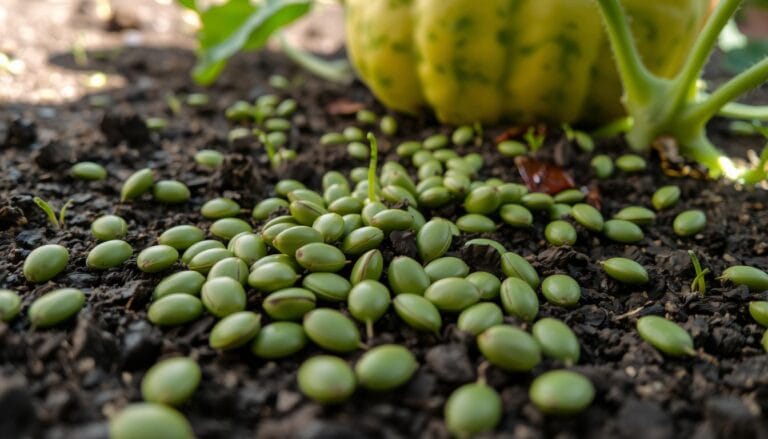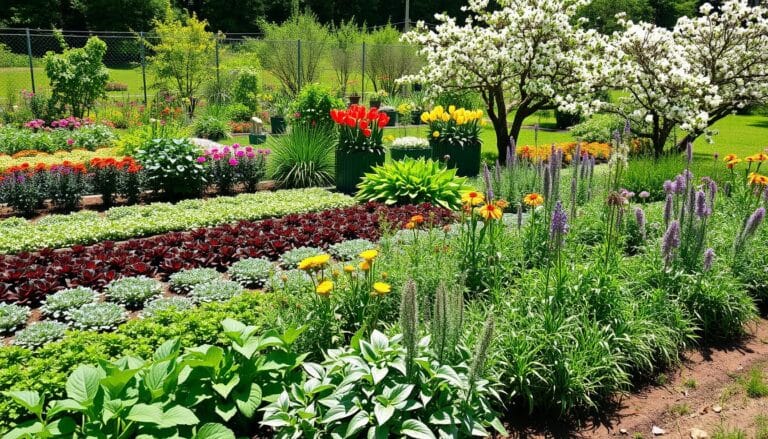How to Protect Frog Pond Plants During Winter

Winter brings a chill to your frog pond, turning it into a fragile ecosystem. It’s vital to know how to care for the plants that live there. With the right steps, your pond can stay healthy even when it’s cold.
This guide is for both new and experienced pond owners. It shows how to protect your plants and keep the pond a safe place for frogs. You’ll learn about managing ice and keeping the water oxygenated. Every choice you make is important for the pond’s health.
Table of Contents
Understanding Winter Challenges for Frog Pond Ecosystems
Winter brings big challenges to frog pond ecosystems. Freezing temperatures, ice, and changing water can harm plants and frogs. These changes affect the balance of these vital wetlands.
Impact of Freezing Temperatures on Aquatic Plants
Ice on ponds traps harmful gases from decomposing leaves. This is called “Winterkill.” It can hurt the health of plants that are crucial for the ecosystem.
Natural Plant Dormancy Cycles
Many plants go dormant in winter to survive. Their growth slows, and they focus on protecting their roots. Knowing these cycles helps keep the pond’s plants healthy.
Effects on Frog Habitats
Winter affects frogs in ponds too. They may sleep at the bottom of the pond as temperatures drop. Shallow ponds freeze completely, which is bad for frogs. Keeping water deep and providing safe spots is key.
Understanding winter challenges helps protect frog ponds. This ensures the survival of plants and frogs.
| Key Challenges for Frog Pond Ecosystems in Winter | Potential Impacts |
|---|---|
| Freezing Temperatures and Ice Formation |
|
| Natural Plant Dormancy Cycles |
|
| Effects on Frog Habitats |
|
Understanding winter challenges helps protect frog ponds. This ensures the survival of plants and frogs.
Do Plants in a Frog Pond Survive During Winter
Many wonder if the plants in their frog pond can survive winter’s cold. The good news is that dormant aquatic plants and overwintering pond vegetation have clever pond plant survival strategies for the cold months.
Submerged plants stay alive even when the pond’s surface freezes. Their roots and stems keep photosynthesizing. This provides oxygen and nutrients for the plant during the cold period. Marginal plants, however, may die back to their roots. They then grow back in the spring.
Keeping the water deep and well-oxygenated is key for plant survival in winter. Plants in deeper water stay warmer. Good aeration also keeps oxygen levels up for their health.
Some plants, like wild roses, can even grow in new places after harsh weather. Native species, which are used to local winters, usually survive better.
“Amphibians are well adapted for cold weather conditions and can survive for long periods beneath the ice if there is enough oxygen in the water.”
While some frogs might not make it through very icy winters, most plants and wildlife can do well with proper care. This care and preparation are crucial for their survival.
By learning about the natural ways dormant aquatic plants, overwintering pond vegetation, and their pond plant survival strategies adapt, pond lovers can keep their habitats lively and healthy. This is true even in the coldest winter months.
Essential Pre-Winter Pond Maintenance Tasks
As winter gets closer, it’s key to get your backyard pond ready. This ensures the health of your plants and animals. By doing some important tasks, you can make your winterizing backyard ponds, pond maintenance, and aquatic garden strong through winter.
Removing Dead Foliage and Debris
Start by removing dead leaves and other debris from your pond. This is crucial to stop harmful gas buildup. Cleaning your pond well is especially important in late winter or early spring. Regular checks are also needed for pond maintenance.
Checking Water Quality Parameters
Then, check your pond’s water quality. Look at pH, oxygen levels, and nutrient balance. Keeping the water quality right is key for your aquatic garden‘s health. Adjust the water if needed to keep it good for your plants and animals in winter.
Preparing Plant Zones
Lastly, get your pond’s plant zones ready for winter. Trim marginal plants to protect their roots from cold. Add objects like logs to stop ice from covering the pond’s surface, which harms submerged plants.
By doing these tasks, you’ll make your winterizing backyard ponds strong and healthy. They’ll support your aquatic ecosystem all winter long.
Managing Ice Formation on Pond Surfaces
Keeping a frog pond healthy in winter needs careful ice management. When it gets cold, don’t break the ice. This can hurt the plants and animals living there. Instead, make small openings to let gas in and keep the water from freezing completely.
Using hot water to melt holes in the ice is a good method. It lets oxygen in without messing up the pond’s balance. You can also use floating objects, like tennis balls, to keep some areas of the pond from freezing.
It’s important to clear snow off the ice. This lets sunlight get to the water, helping plants make oxygen. Keeping the right balance helps protect the frog pond ecosystem and keeps your winter pond care friends safe.
| Ice Thickness Guidelines | Suitable Activities |
|---|---|
| 3 inches or less | Not safe |
| 4 inches | Suitable for certain activities like ice fishing |
| 8 to 12 inches | Safe for a car or a group of people |
Using these ice management methods helps keep your frog pond healthy all winter.
“The annual winter freeze is a significant event in the wood frog’s life cycle and is of special interest to medical researchers for potential applications in areas such as diabetes management and organ transplants.”

Protecting Submerged Aquatic Plants
As winter gets closer, it’s key to focus on your frog pond’s submerged plants. These cold hardy pond plants are vital for the pond’s health. They offer shelter, oxygen, and food for the pond’s creatures. Knowing how to care for them during cold months is important.
Deep Water Plant Care
Submerged plants face a big risk in winter: freezing. To prevent this, keep your pond water deep. Try to have water at least 24 inches deep, with some areas up to 36 inches. This keeps the plants warm enough to go into winter plant dormancy safely.
Root System Protection Methods
- Avoid disturbing the pond bottom sediment, as this can damage the plants’ delicate root systems.
- Consider relocating some of the plants to deeper areas of the pond, where they’ll be better protected from freezing temperatures.
- Maintain water quality by regularly testing and adjusting parameters to support the plants during their dormant phase.
By following these tips, you can keep your pond’s ecosystem healthy. This ensures your submerged plants will survive the winter and bloom again in spring.
“Protecting submerged plants is crucial for the overall health and balance of a frog pond ecosystem.”
Winterizing Marginal Plants and Bog Gardens
As winter gets closer, it’s key to winterize your marginal plants and bog gardens. These plants need special care to survive the cold. Marginal plants grow near water, and bog gardens love moist, swampy spots.
Start by cutting back dead leaves on your marginal plants. But don’t cut too close to the plant’s base. This protects the plant from frost. Also, add mulch or leaves around the base to keep it warm and moist.
If your plants are in pots, move them to deeper water or a sheltered spot. This keeps them moist and safe from freezing.
In your bog garden, keeping the soil moist is important. You don’t want it too wet, but it should stay damp enough for your plants to rest. Check the water level often to keep it just right.
By taking these steps, your overwintering pond vegetation will stay safe and healthy. With the right care, your winterizing backyard ponds will be beautiful for years.

Creating Winter Refuges for Pond Wildlife
As winter comes, it’s key to make safe spots for pond wildlife. The cold months bring challenges like less food and freezing temps. By making winter refuges, you help your pond’s animals stay safe and healthy.
Building Hibernation Areas
Creating hibernation spots is a great way to protect pond animals in winter. You can use logs, rocks, or special hibernacula near the pond. These spots offer shelter and keep animals warm during their sleep.
Maintaining Safe Access Points
It’s also important to keep paths to the pond open. As it gets colder, some areas of the pond should stay ice-free. This lets animals move around and get water when they need it.
By making these refuges, you help your pond’s ecosystem thrive. This supports the health and variety of life in your frog pond ecosystem. It also helps protect seasonal pond cycles and the winter wildlife that live there.
Maintaining Proper Water Depth for Plant Survival
Keeping the right water depth is key for pond plants to survive winter. Make sure there’s at least 18 inches of water in one part of your pond. This keeps plants and wildlife safe from harsh winter weather.
If your pond is shallow, use heaters or bubblers to keep ice away. These tools help keep water warm and prevent ice from covering the whole pond. This way, plant roots stay safe, and creatures have a place to hide.
For potted plants, move them to deeper pond areas when it gets cold. This protects their roots from ice damage. Proper placement can greatly improve plant survival when spring comes.
Right water depth is crucial for pond plant survival strategies and aquatic plant adaptations in winter pond care. It helps create a thriving pond ecosystem. This ecosystem will be ready for new growth and activity when it gets warmer.
“Proper water depth is the foundation for a healthy, balanced pond ecosystem, especially during the winter months. It’s a simple but essential step that can make all the difference in the world for your aquatic plants and wildlife.”
Winter Oxygenation Strategies for Plant Health
Keeping your backyard pond’s oxygen levels up during winter is key for plant health. As it gets colder and ice forms, gas exchange can slow down. This can lead to less oxygen in the water. But, there are ways to keep your pond’s plants well-oxygenated all winter.
Using a pond bubbler or fountain is a good idea. These devices help water move, preventing it from freezing completely. They also help oxygen-rich water circulate. A solar-powered bubbler is a green and cost-effective choice. Also, growing plants like hornwort can help keep oxygen levels up in your pond.
It’s also important to keep the pond’s surface clear of snow. This lets sunlight reach the plants, helping them make oxygen through photosynthesis. This process is vital for plant health and the pond’s ecosystem.
| Oxygenation Strategies | Benefits |
|---|---|
| Pond Bubblers or Fountains | Maintain water movement, prevent complete freezing, and facilitate oxygen circulation |
| Oxygenating Plants (e.g., Hornwort) | Contribute to maintaining healthy oxygen levels in the aquatic garden |
| Clearing Snow from Pond Surface | Allow sunlight penetration to support photosynthesis in submerged plants |
By using these winter oxygenation strategies, you can keep your pond plants healthy through the cold months. This helps not just the plants but also the wildlife that depend on your winter pond care.
Monitoring and Emergency Care During Cold Snaps
Keeping a frog pond healthy in winter needs careful watching, especially when it gets very cold. Plants in your pond, like those in a frog-friendly oasis, can get stressed by cold and ice. By watching for signs of stress and managing temperature, you can help your plants survive winter. This keeps your pond a great place for frogs and plants.
Temperature Management Techniques
When it gets cold, it’s key to stop your pond from freezing over. Think about using pond heaters or bubblers to keep water open. These tools help keep water warm and oxygen levels up, which is vital for plants and frogs.
Signs of Plant Stress
- Discoloration or wilting of foliage
- Excessive ice buildup on submerged plants
- Stunted or slowed growth
- Unusual or unexpected dormancy
If you see any signs of plant stress, act fast. Remove ice, adjust water levels, or add more air to help your plants. This keeps your pond’s balance during winter.
Regular checks and quick action can make a big difference. With the right care, your pond can stay healthy and strong, even when it’s very cold.
Conclusion
To keep your frog pond plants safe during winter, you need a solid plan. This plan should include getting ready, caring for your pond, and knowing the natural cycles of your plants. By doing these things, you can help both plants and animals survive the cold.
It’s important to watch your pond closely and change your care as needed. Being careful and using green practices can help your pond do well, even when it’s cold. Taking good care of your pond’s plants helps the whole ecosystem, making spring even more beautiful.
Whether you’ve had a pond for a long time or are just starting, knowing what your plants and animals need is key. By using the right methods, your pond can stay a lively home for all the creatures that live there, all year round.
FAQ
Do plants in a frog pond survive during winter?
How do freezing temperatures impact aquatic plants and frog habitats?
What are some natural plant dormancy cycles in frog ponds?
What pre-winter maintenance tasks are crucial for frog pond health?
How can you manage ice formation on a frog pond?
How do you protect submerged aquatic plants during winter?
What techniques are used to winterize marginal plants and bog gardens?
Why are winter refuges crucial for pond wildlife survival?
What is the ideal water depth for plant survival in a frog pond during winter?
How can you ensure proper oxygenation for aquatic plants during winter?
What should you monitor during winter, and how should you respond to changing conditions?
Source Links
- Winter worries | Amphibian and Reptile Conservation – https://www.arc-trust.org/news/winter-worries
- Reptiles and Amphibians in Winter: #WinterWildGardening – https://www.froglife.org/2024/10/22/reptiles-and-amphibians-in-winter-winterwildgardening/
- Winter Frogs in Danger: Boosting Australian Frog Populations with Pond – https://weknowwatergardens.com.au/blogs/news/winter-frogs-in-danger-boosting-australian-frog-populations-with-pond-plants-and-habitat-preservation?srsltid=AfmBOoo7IFPbavs6E77JKvibKbeFLUst81Ha26tOInDH3Bqbfaczu3Bp
- Pond Ecosystem Explained: Learn Its Role & Fascinating Facts – https://www.pondandgardendesign.co.uk/blog/what-is-a-pond-ecosystem/
- A tale of Frogs and Ice: what happens in the winter? – https://www.arc-trust.org/news/a-tale-of-frogs-and-ice
- The Frog Pond – delcoculturevultures.com – https://delcoculturevultures.com/in-the-garden/
- How To Clean A Wildlife Pond: Maintenance Guide + Top Tips – https://www.pondandgardendesign.co.uk/blog/how-to-clean-a-wildlife-pond/
- Wildlife Pond Design, Planting and Management – https://balkanecologyproject.blogspot.com/2023/12/wildlife-pond-design-planting-and.html
- How to Create an Ice Rink on Your Pond – https://www.thepondguy.com/learning-center/how-to-create-an-ice-rink-on-your-pond/?srsltid=AfmBOorhxReoaj9rXXJdGqHJvsVXw_OBZxTpWCKghQ2ut9jHHfvj-7xm
- Q: Is it true that some frogs can survive being frozen? – https://www.lcbp.org/2024/01/q-is-it-true-that-some-frogs-can-survive-being-frozen/
- Do Frogs Hibernate? Vet-Approved Facts & FAQ | Hepper – https://www.hepper.com/do-frogs-hibernate/?srsltid=AfmBOopXPOsyf7ahckZ8wMEbOcLjvhB13wgbr4AiOd4efIs6z0M3_apK
- How to Winterize a Pond: Fall Pond Care – https://www.thepondguy.com/learning-center/fall-shutdown/?srsltid=AfmBOoqgRE135riJaPTy7KfnsLJUUGQGVafI_OD71DZ313N-cVLUPZkL
- Pond Plants: Weeds or Beneficial? – Oklahoma State University – https://extension.okstate.edu/fact-sheets/pond-plants-weeds-or-beneficial.html
- Water Gardens: Everything You Need to Know – https://www.lawnstarter.com/blog/landscaping/water-gardens-everything-you-need-to-know/
- Best Plants For Frogs: 7 Plant Varieties To Bring More Froggies To Your Yard – https://www.gardeningknowhow.com/garden-how-to/beneficial/best-plants-for-frogs-7-plant-varieties-to-bring-more-froggies-to-your-yard
- hibernaculum – https://www.froglife.org/tag/hibernaculum/
- | Ozponds – https://ozponds.com/how-to-build-a-budget-friendly-wildlife-pond-a-guide-to-attracting-frogs-and-boosting-biodiversity/
- No title found – https://www.woodlandtrust.org.uk/blog/2024/03/how-to-attract-frogs-to-your-garden/
- How Deep Should A Wildlife Pond Be? Essential Tips Revealed – https://www.pondandgardendesign.co.uk/blog/how-deep-should-a-wildlife-pond-be/
- Water for Wildlife: Bird Baths and Backyard Ponds – https://extension.psu.edu/water-for-wildlife-bird-baths-and-backyard-ponds
- Mid-Atlantic Pocket Guide to Water Garden Species – https://extension.psu.edu/mid-atlantic-pocket-guide-to-water-garden-species
- Everything You Need To Know – Pond Haven – https://pondhaven.com/blogs/guides/why-pond-depth-matters?srsltid=AfmBOoprbExlS9BMV_ONK6Me3MFiHsrOhT96TDvWVlwH9tTG_ij0kztK
- Amphibians and Reptiles – Acadia National Park (U.S. National Park Service) – https://www.nps.gov/acad/learn/nature/amphibians-reptiles.htm
- Natural Resources & Park Rangers – https://www.howardcountymd.gov/natural-resources
- Living with Wildlife in Los Alamos County – https://www.losalamosnm.us/Home/Tabs/Whats-Happening/Living-with-Wildlife
- Smart Shorelands: Keep it Clean to Protect Frogs and Toads – https://www.canr.msu.edu/resources/smart-gardening-for-shorelands-keep-it-clean-to-protect-frogs-and-toads
- Frog Pond DIY Guide – How to Attract Frogs and Build a Pond for Them – https://www.pondsolutions.com/frog-pond-diy-guide/
There are no reviews yet. Be the first one to write one.






